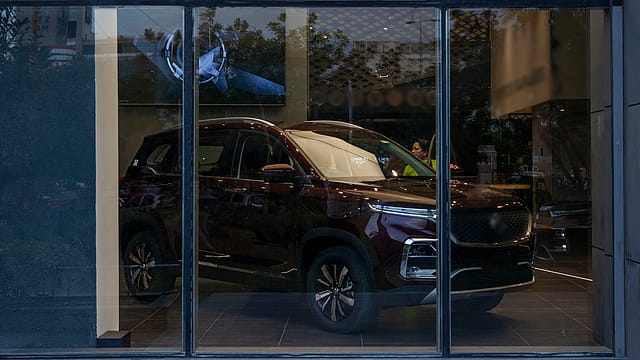SUVs, MPVs account for 65% of passenger vehicle sales in FY25
ADVERTISEMENT

Sport utility vehicles (SUVs) and multi-purpose vehicles (MPVs) contributed 65% to passenger vehicle (PV) sales in India for the financial year 2024-25 compared to about 60% in FY24, according to data released by the Society of Indian Automobile Manufacturers (SIAM).
Passenger vehicle wholesales, dispatches from the factory shop floor to dealerships, grew 2% year-on-year to 4.3 million units in FY25. The moderate growth was due to the high base effect of FY24, said the auto industry association SIAM.
New model launches, packed with advanced features and modern design, resonated strongly with consumer aspirations, said Rajesh Menon, Director General of SIAM. Attractive discounts and promotional offers supported growth momentum and helped sustain volumes, Menon added.
Passenger vehicles also saw their highest-ever exports in FY25 of 0.77 million units, registering a growth of 14.6% as compared to FY24.
“Growth in exports have been driven by demand of global models being manufactured from India in markets of Latin America and Africa. Some companies have also commenced exporting to Developed markets,” said SIAM.
Electric car registrations crossed 1 lakh units in FY25, registering a growth of 18.2% as compared to the previous year.
December 2025
The annual Fortune 500 India list, the definitive compendium of corporate performance, is out. This year, the cumulative revenue of the Fortune 500 India companies has breached $2 trillion for the first time. Plus, find out which are the Best B-schools in India.
The overall automobile industry recorded 7.3% growth in domestic sales, continuing its upward trajectory. Exports rose by 19.2%, reflecting strong global demand. The performance was driven by healthy demand, infrastructure investments, supportive government policies, and continued emphasis on sustainable mobility, SIAM said, adding that sound economic policies and positive market sentiment helped in maintaining growth.
Two-wheelers with sales of 19.6 million units registered a growth of 9.1% in FY25. The recovery was aided by improved rural demand and a resurgence in consumer confidence. “Growth is led by the scooter segment due to improved rural and semi-urban connectivity and availability of newer models with enhanced features,” said SIAM.
The share of electric vehicles (EVs) in two-wheeler sales crossed 6% in FY25, said SIAM. In FY25, two-wheeler exports registered a growth of 21.4% as compared to the previous year with a total of 4.2 million units. “New models and new markets have helped in expanding the footprint of two-wheeler exports. Further, economic stability in the African region and demand in Latin America has supported this growth,” SIAM explained.
Three-wheelers posted their highest-ever sales of 7.4 lakh units in FY25, clocking a growth of 6.7% as compared to previous year, surpassing the previous peak of FY19. The growth was primarily driven by the demand of passenger sub-segment and the rising demand for last-mile mobility solutions, in urban and semi-urban areas including e-vehicles led to this growth.
Commercial vehicles experienced a de-growth of 1.2% in FY25 compared to the previous year. “Though the overall trucks segment has witnessed a slight de-growth, but the requirement of freight movement has been suitably served with fleets migrating towards higher GVW (Gross Vehicle Weight) vehicles,” said SIAM.
In its outlook for the ongoing fiscal, FY26, SIAM said a normal monsoon, as currently forecasted for 2025, is expected to support broader economic activity, especially in rural and semi-urban regions, which would be a tailwind for the auto sector demand. “The sector will also benefit from the reforms in the personal income tax announced in the recent Union Budget of 2025-26, which has been followed by two back-to-back rate cuts by RBI. These measures would help in creating demand by increased accessibility of vehicle financing,” said Menon.
Export demand in key markets of interest, such as Africa and neighbouring countries, is likely to continue as ‘Made in India’ vehicles are gaining traction, said SIAM.
Commenting on the auto sales data, Shailesh Chandra, president of SIAM said, “The Indian automobile industry continued its steady performance in FY25, driven by healthy demand, infrastructure investments, supportive Government policies, and continued emphasis on sustainable mobility."
"Growth rates have been varied across segments. Passenger vehicles and three-wheelers witnessed a moderate growth on account of high base effect, but saw the highest ever sales in these categories, while the two-wheeler segment registered strong growth in FY25," said Chandra.
"On the exports front, good recovery is seen across all segments, particularly passenger vehicles and two-wheelers reflecting improved global demand and India's growing competitiveness. In FY2024-25, the Government of India introduced the PM E DRIVE scheme and PM e-Sewa schemes which underscores the firm commitment of the Government towards promoting sustainable mobility. Looking ahead, the backdrop of stable policy environment, along with recent measures such as reforms in personal income tax and RBI’s rate cuts, will help in supporting consumer confidence and demand across segments," said Chandra.
